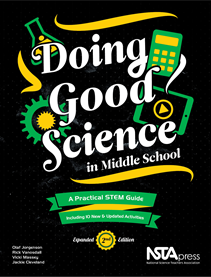Doing Good Science in Middle School
By Carole Hayward
Posted on 2014-04-28
“In our experience, good science—by which we mean activity-based STEM instruction—promotes the unexpected and delightful development of adolescent middle school students.”
–From the preface
 In Doing Good Science in Middle School, Expanded 2nd Edition, authors Olaf Jorgenson, Rick Vanosdall, Vicki Massey, and Jackie Cleveland state that “good science” consists of “active, learner-centered, hands-on and minds-on investigations.” The authors add that “good science and middle school learners are very compatible.” And, if anyone should know about middle school students, it is these four educators. They have more than 130 years of combined experience in middle school education.
In Doing Good Science in Middle School, Expanded 2nd Edition, authors Olaf Jorgenson, Rick Vanosdall, Vicki Massey, and Jackie Cleveland state that “good science” consists of “active, learner-centered, hands-on and minds-on investigations.” The authors add that “good science and middle school learners are very compatible.” And, if anyone should know about middle school students, it is these four educators. They have more than 130 years of combined experience in middle school education.
The authors have taken their experience and created a book filled with active-learning science and engineering investigations. According to the authors, middle schoolers are curious and have a natural interest in learning, but also have short attention spans and a need to be acknowledged as adults. These students do better when the classroom shifts from textbook- and teacher-centered instruction to learner-centered investigations that engage students and foster their independence and curiosity.
When the authors wrote the first edition of this book, published 10 years ago, digital technology and social media did not play a role in everyday life like it does now. So much has changed in 10 years, including the implementation of the Common Core Initiative and the Next Generation Science Standards (NGSS). Therefore, the authors decided to update the book and add 10 new activities that are aligned with the standards and are “more useful in the context of 21st-century skills that teachers today are expected to cultivate in their students.”
Beginning chapters of the book delve into the nature of science, what good science looks like in the classroom, and classroom management. Subsequent chapters focus on the 10 activities, with each chapter addressing a single lesson. In addition to tying the lessons to the Common Core standards and NGSS, the authors provide common misconceptions about each topic, focus questions, and teacher preparation tips. The activities follow the 5E instructional model—engage, explore, explain, elaborate, and evaluate—as a template. The activities cover a number of science and engineering disciplines, including: physical science (magnetism and energy transfer); engineering (structural design); biology (population dynamics/natural selection); Earth science (weather and climate; water conservation); and science and engineering processes (testing and communication).
So, if you are looking for teacher-friendly, ready-to-use STEM activities for middle school students, definitely check out Doing Good Science in Middle School, Expanded 2nd Edition. What you will find is that the featured activities are an excellent fit for “the blossoming intellects, often comical behaviors, and insatiable curiosity of middle schoolers.”
This book is also available an e-book.
Disclaimer: The views expressed in this blog post are those of the author(s) and do not necessarily reflect the official position of the National Science Teaching Association (NSTA).


